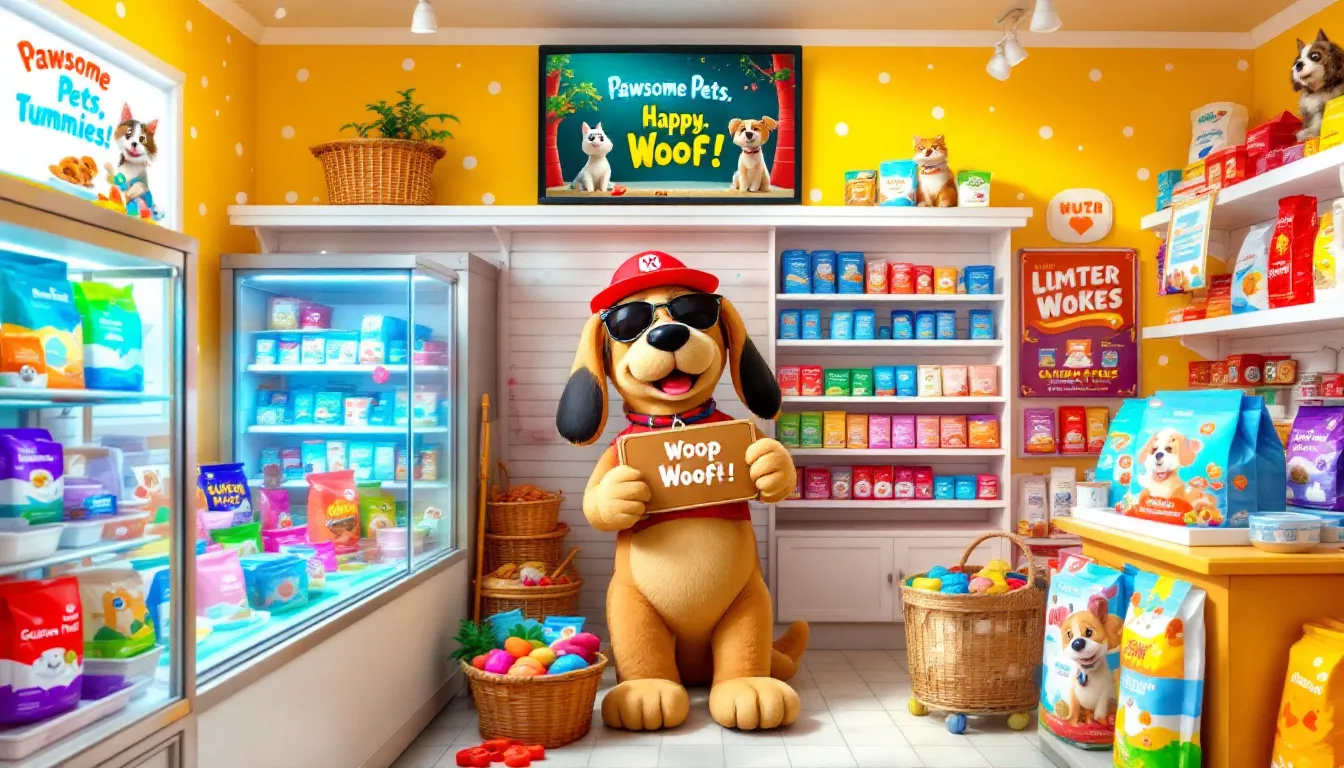Looking to boost your pet food brand’s success? In this article on pet food marketing, we cover essential strategies. You’ll learn about understanding the market, advertising techniques, crafting a USP and leveraging digital marketing to thrive in 2025.
Understanding the pet food market landscape
The global pet food market is a dynamic and rapidly expanding industry. Valued at approximately USD 126.66 billion in 2024, it is projected to reach USD 163.70 billion by 2029, driven by increasing demand for quality nutrition. This growth is fueled by several factors, including the trend of pet humanization, where pets are increasingly seen as family members, leading to a rising demand for premium pet food products and selling pet food. Additionally, the COVID-19 pandemic significantly increased pet ownership, further boosting the pet food market.
North America holds a significant share of the pet food market, accounting for 40.6% in 2024, largely due to high levels of pet ownership. Leading players like Mars Incorporated dominate the market, contributing to the industry’s growth. However, emerging economies are also experiencing rapid growth in pet ownership, contributing to the global expansion of the pet food market.
Grasping these market dynamics helps pet food businesses thrive. Thorough market research and staying updated on industry trends enable pet treat business to tailor their products to meet the evolving demands of pet owners, ensuring competitiveness in this booming market.
Effective advertising techniques for pet food brands
Effective advertising helps pet food brands stand out in a crowded market. Video marketing creates an immersive experience that resonates emotionally with pet owners. Showcasing flavors, textures and benefits through engaging storytelling captivates viewers and enhances brand recall.
Influencer marketing is another powerful tool. By partnering with popular pet influencers who have large followings, pet food brands can significantly enhance their visibility and credibility. User-generated content from these collaborations can further boost brand awareness and foster a sense of community within the pet-loving audience.
Social media platforms showcase pet food products and connect with pet owners through engaging content. A compelling marketing message that grabs attention and generates buzz can attract new customers and foster loyalty. These techniques build brand awareness, drive sales and ensure long-term success for pet food businesses.
Crafting a unique selling point (USP) for your pet food business
In a competitive pet food market, a strong unique selling point (USP) is vital. Recipes catering to specific dietary needs set your brand apart. Features like organic ingredients, special flavors and health benefits make your specialty pet food products stand out.
Connecting emotionally with pet owners is powerful. Sharing a compelling story about your brand’s origins and values creates an emotional connection, fostering customer loyalty. Cat owners, for example, may respond well to products that enhance the bond between them and their cats.
A well-defined USP communicates the distinct features of your pet food and helps create an emotional connection with pet owners, setting your brand apart. This strong USP drives customer loyalty and boosts sales.
Leveraging digital marketing for pet food sales
In today’s digital age, a solid online presence is crucial for pet food brands. The rise in online shopping makes optimized digital marketing strategies essential for sales growth. SEO techniques like schema markup enhance visibility in search results, driving more traffic to your website. Local SEO optimization helps businesses appear in geographic-specific search results, increasing local engagement.
Integrating SEO with PPC campaigns can maximize online visibility and target the right customers effectively. PPC advertising provides precise audience targeting, allowing brands to reach potential customers more effectively. Smart bidding techniques in PPC can optimize ad spend and improve performance through real-time adjustments.
Email marketing nurtures customer relationships by delivering relevant information through targeted campaigns, fostering loyalty and driving repeat purchases. Targeted social media ads, especially through lookalike audiences, enhance visibility and attract new customers, boosting overall sales.
Building customer loyalty in the pet food industry
Building customer loyalty is crucial for long-term success in the pet food industry. Excellent customer service, with multiple contact channels and quick response times, enhances satisfaction and fosters loyalty. Open, direct communication through personalized emails and feedback mechanisms significantly boosts loyalty.
Face-to-face interactions at retail locations strengthen trust and loyalty. Actively seeking feedback and addressing concerns drives positive change and improves brand loyalty. Tracking customer engagement metrics, including feedback and social media interactions, tailors marketing efforts and enhances customer experiences.
Combining traditional and digital communication methods engages customers and fosters loyalty. An easy-to-navigate, mobile-friendly website retains customers and ensures a seamless user experience.
Utilizing social media platforms effectively
A strong presence on social media platforms enhances brand awareness and promotes pet food products. Customizing profiles with branding elements fosters recognition and audience connection. Engaging storytelling and customer images build a community around your brand and foster loyalty.
Engaging followers by asking about their pets, offering exclusive deals and hosting contests increases interaction and broadens your audience reach. Visual content, such as photos and videos, highlights your products effectively and boosts social media engagement.
Using appropriate hashtags improves content discoverability on platforms like Instagram and Twitter. Offering promotional items or discounts through social media entices influencers to share your products, further driving customer engagement and sales.
The role of content marketing in pet food promotion
Content marketing is vital for promoting pet food products. Informative articles help pet owners understand the importance of nutrition and care, establishing your brand as a trusted resource. Infographics visually communicate complex information about pet health and nutrition in an easily digestible format.
Engaging video content informs and entertains, effectively drawing pet owners’ attention to your brand. For exotic pet owners, specialized educational content addressing their unique care and well-being needs is particularly effective.
Consistently providing valuable content builds trust and authority within the pet food market, driving sales and fostering customer loyalty.
Compliance with federal regulations and nutritional standards
Compliance with federal regulations and nutritional standards is paramount in the pet food industry. Adhering to safety standards established by organizations like the American Association of Food Control Officers (AAFCO) ensures your products are safe and meet scientifically validated nutritional requirements.
Regulatory documents serve as reference points for manufacturers, emphasizing the nutritional value and safety of pet food. Ensuring your products are free from harmful substances is critical for maintaining consumer trust and fostering a positive brand reputation.
Targeting specific demographics for maximum impact
Understanding and targeting specific demographics maximizes the impact of your marketing strategies. The target market for pet products includes segments such as pet owners, singles, city dwellers, seniors, families and pet parents.
Tailoring your marketing strategies to the specific needs and preferences of these demographics effectively raises awareness, boosts sales and fosters customer loyalty. Thorough market research to understand your target audience is essential for creating impactful and relevant marketing strategy campaigns.
Measuring the success of your pet food marketing campaigns
Measuring the success of your marketing campaigns is crucial for understanding their effectiveness and optimizing future strategies. Analytics tools for social media help track engagement, allowing you to make data-driven decisions. Monitoring conversion rates evaluates how well your website or campaign drives desired actions from potential customers.
Return on investment (ROI) assesses the profitability of your marketing campaigns by comparing generated revenue to associated costs. Average order value (AOV) provides insights into spending patterns, enabling you to develop strategies that encourage higher transaction values.
Measuring these metrics provides valuable insights into your campaign performance, identifies areas for improvement and ensures that your marketing efforts drive the desired results.
Role of consulting firms
Consulting firms play a crucial role in the pet food industry. Firms like GC Consulting, with over 10 years of industry experience, assist businesses with pet food marketing and sales. They have built an extensive network of manufacturers, distributors and brand owners, offering valuable assistance to expand pet food businesses.
Fostering trust and providing expert guidance, consulting firms help pet food businesses navigate market complexities, develop effective marketing strategies and achieve sustainable growth.
Summary
Summarize the key points from the blog, highlighting the importance of understanding the market landscape, effective advertising, a strong USP, digital marketing and building customer loyalty. Reiterate the role of compliance, targeting specific demographics and measuring campaign success.
End with an inspiring phrase encouraging readers to implement these strategies to achieve remarkable growth in the pet food industry.
Frequently asked questions
Why is it important to understand the pet food market landscape?
It's crucial to understand the pet food market landscape to effectively adapt products to the changing preferences of pet owners, ensuring competitiveness and relevance in the industry.
How can video marketing benefit pet food brands?
Video marketing can effectively engage pet owners by emotionally connecting them to the brand through storytelling that highlights the flavors, textures, and benefits of pet foods. This immersive approach can enhance brand loyalty and drive sales.
What role does a unique selling point (USP) play in the pet food industry?
A unique selling point (USP) is essential in the pet food industry as it highlights your product's distinct features, fosters an emotional connection with pet owners, and differentiates your brand from competitors. This clarity can significantly influence purchasing decisions.
How can digital marketing strategies boost pet food sales?
Implementing digital marketing strategies such as SEO, PPC campaigns and email marketing can significantly boost pet food sales by enhancing online visibility and effectively targeting and nurturing customer relationships. This focused approach results in higher engagement and increased sales.
Why is it essential to comply with federal regulations and nutritional standards?
It is essential to comply with federal regulations and nutritional standards because it guarantees the safety and nutritional quality of pet food products, which in turn builds consumer trust and strengthens brand reputation.



